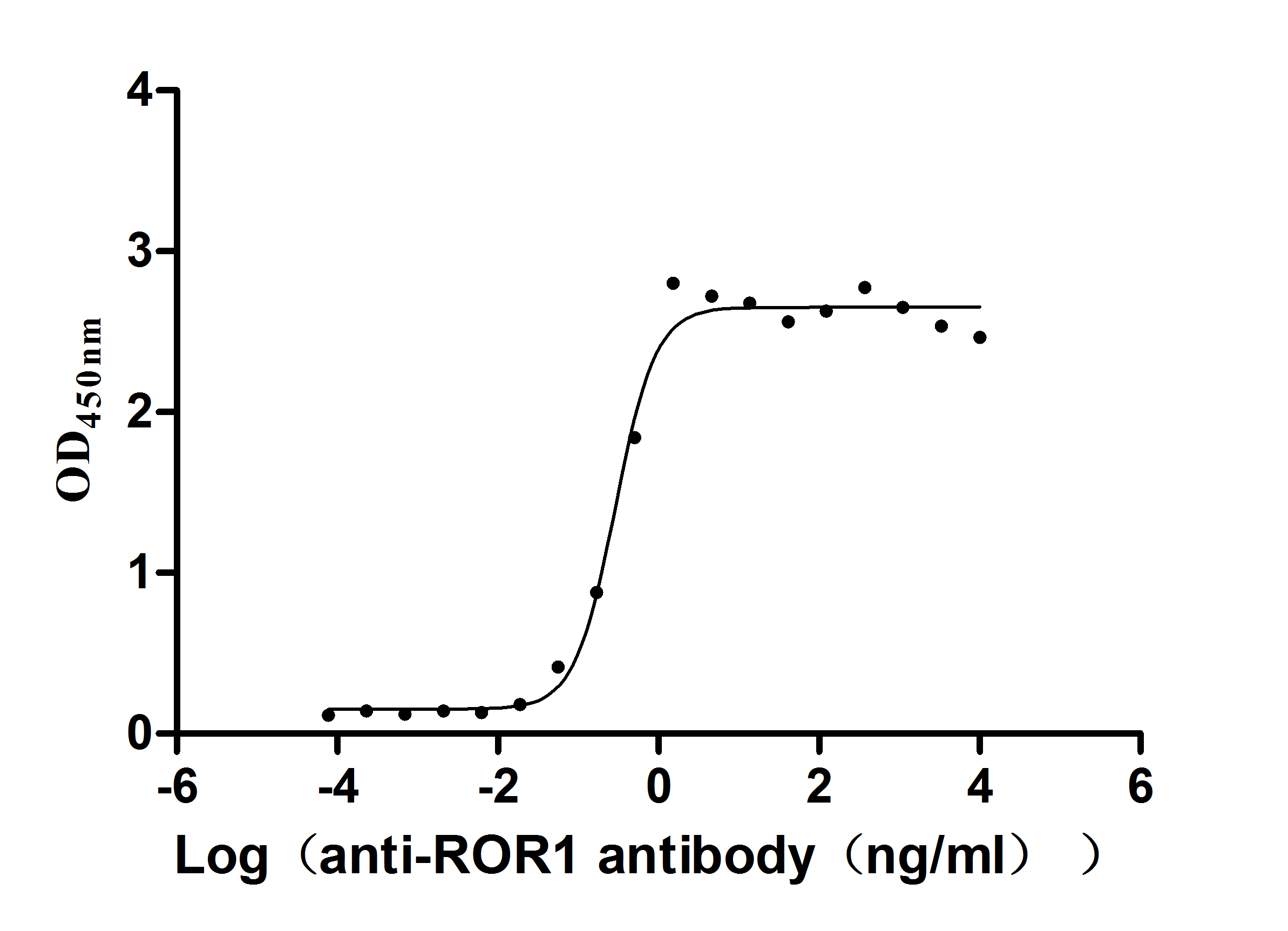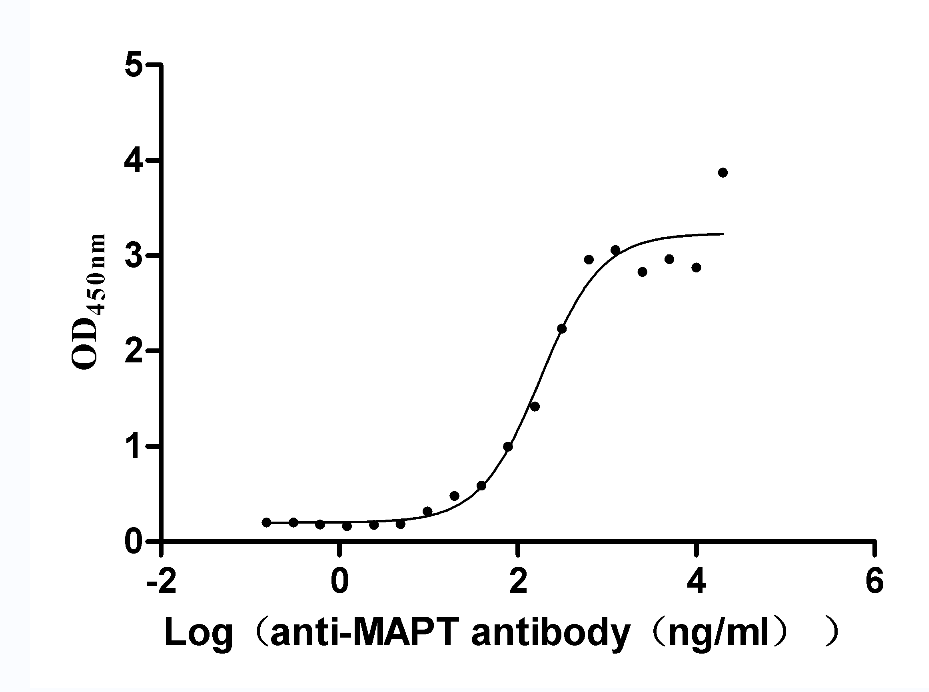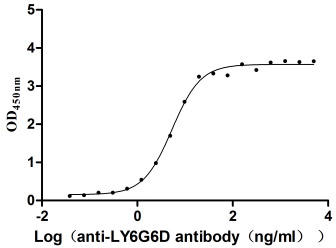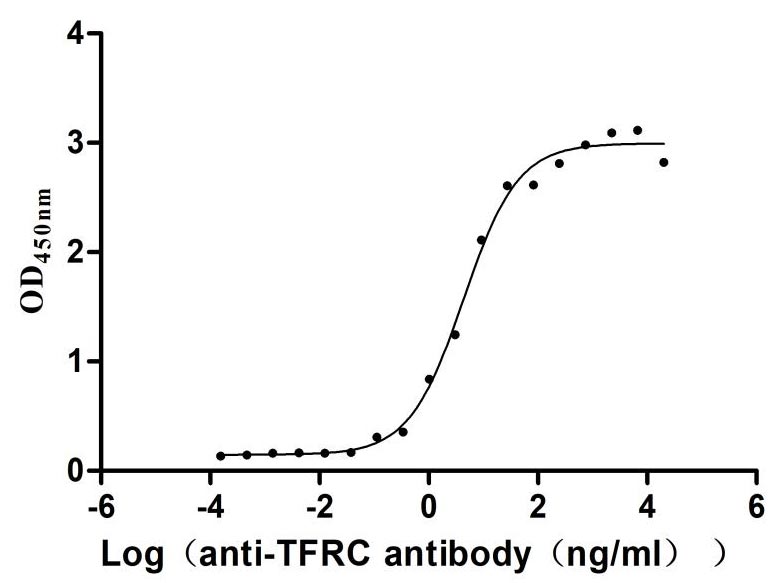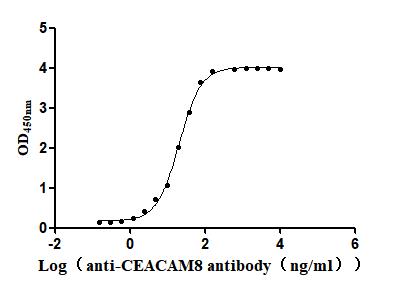Recombinant Human Prostaglandin D2 receptor (PTGDR), partial
-
中文名稱:人PTGDR重組蛋白
-
貨號:CSB-YP621658HU1
-
規格:
-
來源:Yeast
-
其他:
-
中文名稱:人PTGDR重組蛋白
-
貨號:CSB-EP621658HU1-B
-
規格:
-
來源:E.coli
-
共軛:Avi-tag Biotinylated
E. coli biotin ligase (BirA) is highly specific in covalently attaching biotin to the 15 amino acid AviTag peptide. This recombinant protein was biotinylated in vivo by AviTag-BirA technology, which method is BriA catalyzes amide linkage between the biotin and the specific lysine of the AviTag.
-
其他:
-
中文名稱:人PTGDR重組蛋白
-
貨號:CSB-BP621658HU1
-
規格:
-
來源:Baculovirus
-
其他:
-
中文名稱:人PTGDR重組蛋白
-
貨號:CSB-MP621658HU1
-
規格:
-
來源:Mammalian cell
-
其他:
產品詳情
-
純度:>85% (SDS-PAGE)
-
基因名:PTGDR
-
Uniprot No.:
-
別名:PTGDR; Prostaglandin D2 receptor; PGD receptor; PGD2 receptor; Prostanoid DP receptor
-
種屬:Homo sapiens (Human)
-
蛋白長度:Partial
-
蛋白標簽:Tag?type?will?be?determined?during?the?manufacturing?process.
The tag type will be determined during production process. If you have specified tag type, please tell us and we will develop the specified tag preferentially. -
產品提供形式:Lyophilized powder
Note: We will preferentially ship the format that we have in stock, however, if you have any special requirement for the format, please remark your requirement when placing the order, we will prepare according to your demand. -
復溶:We recommend that this vial be briefly centrifuged prior to opening to bring the contents to the bottom. Please reconstitute protein in deionized sterile water to a concentration of 0.1-1.0 mg/mL.We recommend to add 5-50% of glycerol (final concentration) and aliquot for long-term storage at -20℃/-80℃. Our default final concentration of glycerol is 50%. Customers could use it as reference.
-
儲存條件:Store at -20°C/-80°C upon receipt, aliquoting is necessary for mutiple use. Avoid repeated freeze-thaw cycles.
-
保質期:The shelf life is related to many factors, storage state, buffer ingredients, storage temperature and the stability of the protein itself.
Generally, the shelf life of liquid form is 6 months at -20°C/-80°C. The shelf life of lyophilized form is 12 months at -20°C/-80°C. -
貨期:Delivery time may differ from different purchasing way or location, please kindly consult your local distributors for specific delivery time.Note: All of our proteins are default shipped with normal blue ice packs, if you request to ship with dry ice, please communicate with us in advance and extra fees will be charged.
-
注意事項:Repeated freezing and thawing is not recommended. Store working aliquots at 4°C for up to one week.
-
Datasheet :Please contact us to get it.
相關產品
靶點詳情
-
功能:Receptor for prostaglandin D2 (PGD2). The activity of this receptor is mainly mediated by G(s) proteins that stimulate adenylate cyclase, resulting in an elevation of intracellular cAMP. A mobilization of calcium is also observed, but without formation of inositol 1,4,5-trisphosphate. Involved in PLA2G3-dependent maturation of mast cells. PLA2G3 is secreted by immature mast cells and acts on nearby fibroblasts upstream to PTDGS to synthesize PGD2, which in turn promotes mast cell maturation and degranulation via PTGDR.
-
基因功能參考文獻:
- PGD2 signaling through the D-prostanoid receptor 1 (DP1) receptor is necessary for optimal microglia/macrophage activation and IFN expression after infection with a neurotropic coronavirus PMID: 28630327
- Polymorphisms of prostaglandin D receptor (PTGDR) gene influence basal promoter activity and gene expression, as well as the cytokine secretory pattern. PMID: 29088248
- An association was found between single nucleotide polymorphisms of the PTGFR and SLCO2A1 genes and the response to latanoprost in Han Chinese patients with glaucoma. These SNPs may be important determinants of differential response to latanoprost. PMID: 27336732
- EP2 receptors seem to be able to distinguish endogenous ligands PGD2, PGE2 or prostaglandin F2alpha better than DP receptors. PMID: 27636113
- PGD2 markedly augments disease activity through its ability to enhance the proinflammatory actions of macrophages and subsequent neutrophil activation. PMID: 26792210
- Non-obligatory role of prostaglandin D2 receptor subtype 1 in rosacea: laropiprant in comparison to a placebo did not alleviate the symptoms of erythematoelangiectaic rosacea PMID: 25142778
- EP2 receptors exhibit more constraints to mutations than DP receptors. PMID: 25681680
- Low DP1 prostanoid receptor is associated with gastric cancer progression. PMID: 24922638
- Lipocalin-type prostaglandin D2 (PGD2) synthase (L-PGDS) interacts intracellularly with the G protein-coupled receptor DP1 in an agonist-independent manner. PMID: 24493589
- the PTGDR -549 C/T polymorphism confers susceptibility to asthma in Europeans and adults. However, no association was found between the PTGDR 441 C/T and -197 C/T polymorphisms or the CCC and TCT haplotypes and asthma susceptibility. PMID: 23192614
- Genetic variant may play a role in NSAID induced acute urticaria. PMID: 23181793
- PGD(2)-DP signaling reduces vascular permeability via endothelial cAMP/PKA/Tiam1/Rac1 pathway. PMID: 23307871
- The PTGDR -441C/T polymorphism is not associated with asthma or its phenotypes in the North Indian population. PMID: 22182808
- DP receptors amplify the biological response to CRTH2 activation and the CRTH2/DP heteromer might represent both a functional signaling unit for PGD(2) and a potential target for development of heteromer-directed therapy for allergic diseases PMID: 21930295
- Genetic combinations described have functional implications in the PTGDR promoter activity by changing the transcription factors affinity that will help characterize different risk groups. PMID: 21883277
- PGD(2) can induce MUC5B overproduction via ERK MAPK/RSK1/CREB signaling and that DP1 receptor may have suppressive effects in controlling MUC5B overproduction in the airway. PMID: 21832046
- Polymorphisms of the PTGDR and LTC4S influence responsiveness to leukotriene receptor antagonists in Korean children with asthma. PMID: 21307858
- DP mediates eosinophils through the elevation of intracellular cAMP production but does not change CRTH2 expression; balance between DP and CRTH2 could influence the degree of PGD2-induced eosinophil migration PMID: 21624751
- during allergen-elicited eosinophilic inflammatory reactions, cysteinyl-leukotriene production is regulated by DP1/DP2-orchestrated eosinophil activation PMID: 20973774
- DP(1) receptors coupled to G(alphas) increase adenylate cyclase activity and cAMP/protein kinase A-dependent formation of lipid bodies, and DP(2) receptors coupled to G(alphai) increase calcium; each of these signals is required for LTC(4) production PMID: 21426314
- These results suggest that despite the non-significant findings in the present study populations, prostanoid D2 receptor promoter haplotypes may account for a small but significant proportion of the risk of asthma in Caucasian populations. PMID: 21199159
- Mast cell-derived prostaglandin D2 controls hyaluronan synthesis in human orbital fibroblasts via DP1 activation: implications for thyroid eye disease. PMID: 20308056
- Prostanoid DP receptor (PTGDR) polymorhisms variants was found in a subset of mothers with post-coital associated preterm births PMID: 19710676
- New polymorphisms of human prostanoid DP receptor gene. PMID: 12002745
- Association of a new-type prostaglandin D2 receptor CRTH2 with circulating T helper 2 cells in patients with atopic dermatitis. PMID: 12230502
- amino acid sequence alignment of human, mouse and rat DP receptors PMID: 12895603
- Activation of the D prostanoid receptor DP1 impedes the TNF-alpha-induced migration of Langerhans cells (LC) from skin explants and strongly inhibits chemotactic responses of LC precursors and maturing LCs to CC chemokine ligands 20 and 19, respectively. PMID: 15004188
- Our functional and genetic findings identify PTGDR as an asthma-susceptibility gene. PMID: 15496624
- DP2 might play a critical role in allergic diseases PMID: 15749909
- activation of the prostanoid DP receptor on THP-1 cells enhances TNF-alpha-induced MCP-1 and IL-8 production via the cAMP/PKA signaling pathway PMID: 17307163
- study demonstrated significant evidence of association between polymorphisms in PTGDR with asthma phenotypes in two Caucasian populations PMID: 17538632
- Review. PGD(2) exerts its effects partly through the D-prostanoid receptor. The distribution of DP expression depends on the type of tissue and environment with/without inflammation. PMID: 17541272
- These results suggest that the three PTGDR gene promoter polymorphisms studied are not important risk factors for asthma susceptibility in the Chinese Han population. PMID: 17845306
- D-type prostanoid (DP) receptors comediate with CRTH2 the mobilization of eosinophils from bone marrow and their chemotaxis, which might provide the rationale for DP antagonists in the treatment of allergic disease PMID: 17878378
- activation of DP(1) may contribute to the long lasting blood flow changes in the target organ--REVIEW PMID: 17965752
- Expression of prostaglandin E(2) receptors (EP(2), EP(3), EP(4)), prostaglandin D(2) receptor (DP(2)), prostanoid thromboxane A(2) receptor (TP) and to a lesser extent EP(1) were observed in several hair follicle compartments. PMID: 18005048
- level of exptression in nasal polyps correlates with chronic rhinosinusitis associated with bronchial asthma PMID: 18797183
- These results suggest that expression of DP and CRTH2 is associated with the pathophysiology of chronic rhinosinusitis, and the expression of these receptors may be regulated by h-PGDS and PGD. PMID: 18802357
- promoter polymorphism association in Spanish children with asthma PMID: 18811623
- PGD(2) induces HO-1 mRNA expression through DP2 receptor, linking the PGD(2)-DP2 signaling with heme homeostasis. PMID: 18957281
- Our results do not support PTGDR to be a major candidate gene for asthma traits and atopy in Chinese children. PMID: 19220773
顯示更多
收起更多
-
相關疾病:Asthma-related traits 1 (ASRT1)
-
亞細胞定位:Cell membrane; Multi-pass membrane protein.
-
蛋白家族:G-protein coupled receptor 1 family
-
組織特異性:Expressed in retinal choroid, ciliary epithelium, longitudinal and circular ciliary muscles, iris, small intestine and platelet membranes.
-
數據庫鏈接:
Most popular with customers
-
Express system: Mammalian cell
Species: Homo sapiens (Human)
-
Recombinant Rat Microtubule-associated protein tau (Mapt) (Active)
Express system: Mammalian cell
Species: Rattus norvegicus (Rat)
-
Recombinant Macaca fascicularis lymphocyte antigen 6 family member G6D (LY6G6D) (Active)
Express system: Yeast
Species: Macaca fascicularis (Crab-eating macaque) (Cynomolgus monkey)
-
Recombinant Human Transferrin receptor protein 1 (TFRC), partial (Active)
Express system: Mammalian cell
Species: Homo sapiens (Human)
-
Recombinant Human Carcinoembryonic antigen-related cell adhesion molecule 8(CEACAM8) (Active)
Express system: Mammalian cell
Species: Homo sapiens (Human)


